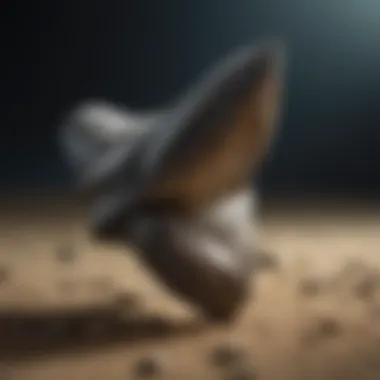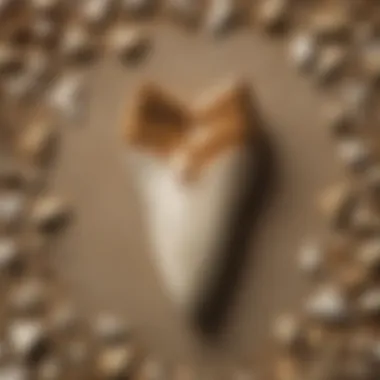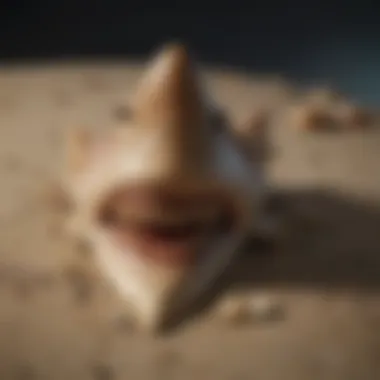Unraveling the Enigmatic Real Shark Tooth: An In-Depth Guide for Collectors


Rock and Fossil Identification
In the fascinating realm of real shark tooth collection, understanding rock and fossil identification is paramount. Different types of rocks and fossils can yield unique specimens, each with distinct characteristics to look for. As an avid collector, having the right tools for identification is crucial in distinguishing genuine shark teeth from replicas or misidentified items. Acquiring a keen eye for detail and honing in on specific features will enhance your ability to curate an authentic and valuable collection.
Collecting Tips and Techniques
When immersing yourself in the world of collecting real shark teeth, adopting best practices is essential. It is vital to research and locate prime collecting sites where a bountiful array of specimens can be unearthed. Moreover, understanding how to safely and effectively extract specimens without causing damage is a skill that all collectors should master. By implementing proper techniques and being conscientious in your approach, you can elevate your collection with rare and high-quality shark teeth.
Preservation and Display
Preserving your prized shark teeth collection requires meticulous care and attention to detail. Utilizing techniques such as cleaning, drying, and storing specimens correctly will ensure their longevity and prevent degradation over time. Properly storing your collection in suitable containers and environments will safeguard the integrity of the shark teeth, preserving their beauty and value for years to come. Additionally, exploring creative display ideas can enhance the aesthetic appeal of your collection, turning it into a striking showcase of geological wonders.
Geological Insights
Delve into the geological insights offered by real shark teeth to unravel their mysteries. Understanding the geological formations and processes that contribute to the formation of these fossils provides valuable context to their origins. Discover the historical significance of shark teeth in archaeological and paleontological studies, shedding light on their role in past ecosystems and marine environments. Explore notable discoveries in the field of shark tooth collection, from groundbreaking findings to intriguing scientific revelations that continue to capture the imagination of enthusiasts worldwide.
Introduction
In the vast world of geological treasures, the allure of authentic shark teeth stands out as a fascinating subject for collectors. As we embark on this journey exploring the mystique of real shark teeth, it becomes evident that these specimens hold not only scientific significance but also cultural and historical value. Understanding the origins and formation of shark teeth provides a window into the evolutionary history of these creatures that have roamed the oceans for millions of years. The intricate process of deposition and fossilization encapsulates a story of time and transformation, making each shark tooth a relic from a bygone era.
Types and varieties of shark teeth present collectors with a diverse array of shapes, sizes, and designs. From fossilized specimens that carry the weight of ancient marine worlds to modern shark teeth that reflect the present-day species, each type offers a unique glimpse into the diversity and adaptation of these apex predators. Exploring the distinctive features, including variations in shape, size, and characteristics across different species, further enriches the journey of discovery for enthusiasts.
Identification techniques play a crucial role in discerning genuine shark teeth from replicas or mimics. Through key markers such as root structure and serrations, collectors can unravel the authenticity of their specimens and appreciate the intricate details that set true shark teeth apart. By honing in on these distinguishing features, enthusiasts can navigate the complex landscape of shark tooth collection with confidence and precision.
As we delve deeper into the world of real shark teeth, this comprehensive guide aims to shed light on the nuances of preservation and care. From cleaning methods that ensure the longevity of specimens to storage practices that maintain their pristine condition, collectors can adopt conservation tips and ideal storage conditions to safeguard their treasured pieces. By understanding the cultural significance of shark teeth, we gain a holistic perspective that transcends the scientific realm, appreciating these fossils as echoes of a primordial past.


Understanding Real Shark Tooth
Understanding the intricacies of real shark teeth is fundamental to the exploration of geological treasures. In this article, we delve into the significance of comprehending the nature of shark teeth, emphasizing its role in aiding collectors to distinguish between authentic specimens and replicas. By gaining a deep understanding of real shark teeth, enthusiasts can appreciate the rich history and unique characteristics embedded within these treasures. This section serves as a cornerstone for enlightening collectors about the origins, types, and distinctive features of genuine shark teeth.
Origins and Formation
Evolutionary History
Exploring the evolutionary history of shark teeth provides invaluable insights into the ancient lineage of these fascinating specimens. The adaptation of shark teeth over millions of years showcases the remarkable evolution of these creatures and their predatory nature. Understanding the evolutionary context of shark teeth enhances the overall appreciation and fascination for collectors, highlighting the intricate relationship between form and function. Evolutionary history stands as a crucial aspect of this article, shedding light on the remarkable journey these teeth have undergone throughout time.
Deposition Process
Delving into the deposition process of shark teeth unravels the geological forces at play in their formation. The intricate layers of sedimentation and mineralization contribute to the preservation of these teeth over millennia, offering a glimpse into the environmental conditions that shaped their existence. Through understanding the deposition process, collectors can discern the subtle nuances that differentiate genuine fossils from mere imitations. This detailed exploration of deposition enriches the collector's knowledge base, enabling them to appreciate the geological processes that culminated in the creation of these prized specimens.
Types and Varieties
Fossilized Shark Teeth
The study of fossilized shark teeth provides a window into prehistoric ecosystems and the diverse species that once roamed the oceans. Fossils offer a tangible connection to ancient marine life, allowing collectors to hold a piece of history in their hands. The durability and unique markings of fossilized teeth make them sought-after specimens among collectors, showcasing the immense age and complexity embedded in these artifacts. Understanding the characteristics of fossilized shark teeth enhances the collector's ability to differentiate between various species, fostering a deeper appreciation for the evolutionary processes that have shaped these relics.
Modern Shark Teeth
Contrasting with their fossilized counterparts, modern shark teeth display the vibrant diversity of current shark species. These teeth reflect the hunting strategies and feeding habits of contemporary sharks, illustrating the ongoing evolution of these fascinating creatures. The study of modern shark teeth presents collectors with a contemporary perspective on shark biology, highlighting the adaptability and resilience of these apex predators. By examining modern specimens, collectors can bridge the gap between past and present, understanding the enduring legacy of sharks in the marine ecosystem.
Distinctive Features
Shape and Size


The morphological characteristics of shark teeth, including their shape and size, offer valuable clues about the species to which they belong. The serrated edges and pointed tips of shark teeth indicate their predatory nature, showcasing adaptations for efficient hunting. By analyzing the shape and size of these teeth, collectors can discern the ecological roles and behaviors of different shark species, enriching their understanding of marine ecosystems. The meticulous examination of these distinctive features enables collectors to identify variations in tooth morphology, facilitating accurate classification and categorization of specimens.
Characteristics of Different Species
Exploring the specific attributes of various shark species through their teeth provides a nuanced understanding of their biology and ecology. Different species exhibit distinctive features in their teeth, such as variations in serration patterns and enamel composition, reflecting their dietary preferences and habitat preferences. By investigating the characteristics of different species through their teeth, collectors can unravel the diversity and specialization present in the shark population, appreciating the complexity and beauty of nature's design. This detailed analysis of species-specific features enhances the collector's expertise in distinguishing between shark teeth of varying origins, fostering a deeper respect for the evolutionary adaptations that have shaped these remarkable creatures.
Identification Techniques
In the realm of real shark teeth collection, mastering identification techniques holds paramount significance. The ability to discern authentic specimens from replicas not only enriches a collector's expertise but also safeguards against falling prey to counterfeits. Identification techniques serve as the cornerstone of this article, providing collectors with the necessary tools to navigate the intricate world of shark tooth acquisition. By shedding light on key markers and comparison methods, enthusiasts can elevate their understanding and appreciation for these geological marvels.
Key Markers
Root Structure
Root structure, a pivotal element in identifying real shark teeth, plays a crucial role in distinguishing between ancient fossils and contemporary imitations. The intricate network of ridges and crevices characteristic of root structures offers invaluable insight into the tooth's authenticity. A genuine root structure exhibits a unique pattern, reflecting the species it belongs to and the environment it originated from. Its durability and resilience are unparalleled, standing as a testament to its age and geological history. Collectors gravitate towards specimens with well-preserved root structures due to their reliability and scientific value, making them highly sought-after additions to any collection.
Serrations
Serrations, another key marker in the realm of real shark tooth identification, serve as a defining feature that sets apart genuine specimens from counterfeit reproductions. These fine serrated edges, finely etched along the tooth's surface, bear testimony to the tooth's predatory past. The presence of sharp, intact serrations indicates the tooth's functionality as a cutting tool for prehistoric sharks, underscoring its authenticity and evolutionary significance. Discerning collectors value serrations for their precision and intricacy, viewing them as crucial indicators of a tooth's genuine nature. By honing in on these minute details, collectors can navigate the market with confidence and discernment, ensuring that their acquisitions possess both aesthetic appeal and scientific merit.
Comparison to Mimics
Delving deeper into the realm of shark tooth authentication, the ability to distinguish genuine specimens from replicas emerges as a key skill for collectors. By scrutinizing purportedly real shark teeth against mimicry attempts, collectors can unveil subtle discrepancies that betray a tooth's true nature. Through methods such as visual inspection, microscopic analysis, and chemical testing, enthusiasts can uncover telltale signs of authenticity or fabrication. Distinguishing genuine specimens from replicas empowers collectors to make informed choices, safeguarding their collections from fraudulent additions and ensuring the integrity of their acquisitions. The capacity to discern minute details that separate authentic artifacts from clever imitations speaks to a collector's expertise and dedication to preserving the legacy of these ancient treasures.
Preservation and Care


Preservation and care are paramount when it comes to authentic shark teeth, ensuring their longevity and pristine condition for collectors. In the realm of geological treasures, such meticulous attention to maintenance can elevate the value and significance of these specimens. Proper preservation practices not only safeguard the physical integrity of the shark teeth but also contribute to the overall appreciation of their historical and scientific importance.
Cleaning Methods
Conservation Tips
Delving into the realm of conservation tips unveils a pivotal aspect of ensuring the sustained beauty and allure of real shark teeth. Conservation tips are intricately designed to preserve the authenticity and integrity of these treasures with utmost precision. The meticulous application of conservation tips serves not only to maintain the aesthetic appeal of shark teeth but also to safeguard their inherent historical and geological value. A key characteristic of conservation tips lies in their ability to delicately clean and protect shark teeth without compromising their natural features. This meticulous approach ensures that collectors can enjoy these geological wonders for generations to come. The unique feature of conservation tips lies in their gentle yet effective cleaning properties, which delicately remove impurities and sediment accumulation while preserving the original essence of the shark teeth. Embracing conservation tips as part of preservation practices in this article exemplifies a conscientious and respectful approach to caring for these ancient artifacts.
Storage Practices
Exploring the significance of storage practices sheds light on the crucial role they play in maintaining the pristine condition of real shark teeth. Ideal conditions for storage not only protect these geological treasures from environmental factors but also showcase a dedication to their preservation. Highlighting the key characteristic of ideal conditions emphasizes the importance of a controlled environment, free from moisture and temperature fluctuations, to prevent any deterioration or damage to the shark teeth. This deliberate choice ensures that collectors can showcase their prized possessions in optimal settings, enhancing their aesthetic appeal and longevity. The unique feature of ideal conditions lies in their ability to create a stable and secure habitat for shark teeth, safeguarding them from potential harm. While ideal conditions offer numerous advantages in preserving real shark teeth, such as preventing decay and discoloration, it is essential to carefully consider the specific needs of each specimen when implementing storage practices in this article.
Cultural Significance
The exploration of real shark teeth extends beyond geological fascination and collector's delight; it holds a profound cultural significance that echoes through history and tradition. Shark teeth have been revered by various civilizations as symbols of strength, power, and protection. In ancient Polynesian culture, shark teeth, known as "Niho mano," were used in elaborate jewelry and weapons, signifying courage and resilience. Similarly, in Hawaiian customs, receiving a shark tooth necklace called "Lei O Mano" symbolizes protection and good fortune.
Moreover, shark teeth hold significance in indigenous cultures worldwide, where they are believed to embody the essence of the ocean and the primal forces of nature. The Maori people of New Zealand, for instance, view shark teeth, or "Mako," as powerful talismans representing adaptability and determination. In many African communities, shark teeth are incorporated into rituals and ceremonies to channel the shark's predatory instincts for hunting and success.
Beyond their spiritual and symbolic value, shark teeth also play a role in contemporary culture, reflecting a deep-rooted connection between humans and the marine world. From artistic expressions to fashion statements, shark teeth continue to captivate minds and inspire creativity. Jewelry designers often incorporate real shark teeth into their pieces, adding an edgy and primal touch to modern accessories.
Furthermore, the conservation efforts associated with shark teeth collection promote marine ecosystem awareness and advocacy. By understanding the value of these geological treasures beyond their monetary worth, collectors contribute to preserving the oceans and the creatures within them. Embracing the cultural significance of shark teeth fosters a sense of responsibility towards environmental conservation and sustainable practices.
Conclusion
In the realm of shark tooth collection, the culmination of understanding the mystique of real shark teeth is a significant journey that unveils a multitude of insights and appreciation for these geological artifacts. Throughout this comprehensive guide, we have traversed through the origins, identification techniques, preservation methods, and cultural significance of real shark teeth. As we conclude this expedition, it becomes evident that the topic of real shark teeth holds paramount importance in the landscape of geological treasures.
At the essence of this exploration is the revelation of the intricate process of how these prized possessions come into existence. By comprehending the origins and formation of shark teeth, collectors gain a profound respect for the evolution and deposition processes that ultimately lead to the creation of these enduring relics. This understanding not only enhances their value as collectibles but also deepens the connection between enthusiasts and the natural world.
Moreover, the detailed examination of identification techniques ingrained in this guide equips collectors with the essential knowledge to discern genuine shark teeth from replicas. The emphasis on key markers such as root structure and serrations elevates the collector's expertise, enabling them to make informed decisions and avoid falling prey to counterfeit treasures. This skill not only safeguards the integrity of collections but also fosters a sense of accomplishment in being able to differentiate between authentic specimens and imitations.
Furthermore, the preservation and care section underscores the importance of maintaining the pristine quality of shark teeth. By learning about proper cleaning methods, conservation tips, and storage practices, collectors can ensure the longevity of their prized possessions while upholding their intrinsic beauty and scientific value. This aspect not only adds a level of responsibility to the collecting process but also serves as a testament to the dedication and passion exhibited by collectors.
In a larger context, the cultural significance of real shark teeth transcends their geological attributes, offering a window into ancient traditions, beliefs, and practices. By appreciating the historical and symbolic importance of shark teeth across different cultures, collectors not only deepen their understanding of these artifacts but also enrich their overall collecting experience with a cultural lens.







